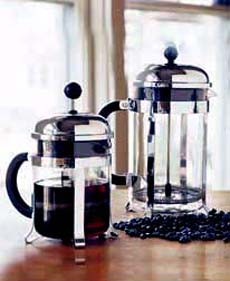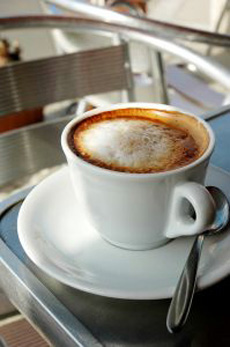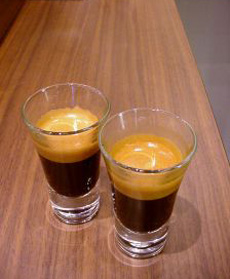Coffee Glossary: A Glossary Of The Different Coffee TypesPage 2: Terms Beginning With C This is Page 2 of an 6-page article. Click on the red links below to visit other pages. This glossary is protected by copyright and cannot be reproduced in whole or part. You are welcome to link to it.
|
 Many serious coffee drinkers prefer to brew their coffee in a French press. These French presses, by Bodum, are available at Sur La Table. |
|
| Café and Caffe: The French and Italian words, respectively, for both coffee, the drink, and coffee shop, the place where one can drink it. |
||
| Café Canario: In Spain, a café solo topped with sweet, thick milk. Café Con Hielo: A sweetened iced coffee served in Spain. |
||
| Café Solo: The Spanish term for espresso. See our Espresso Glossary for more espresso definitions. |
||
| Caffe Americano: The Italian word for coffee or coffee shop. The French and Spanish word is café. The German word is Kaffee. |
||
| Caffe Americano: A single or double shot of espresso poured over six ounces of fresh hot water to produce a milder (“American-style”) coffee. Unlike with American coffee, the crema should rise to the top of the finished beverage. |
||
| Caffe Breva: A cappuccino made with half and half, instead of whole milk. |
||
| Caffeine: A bitter alkaloid contained in coffee and tea that stimulates the central nervous system and, in the right amounts, causes adrenaline to be released. Caffeine can enhance heart function, and is said to help with intellect. Too much caffeine can over-stimulate and cause discomfort. |
||
| Caffe Latte: A coffee drink made with a double shot of espresso topped with steamed milk and finished with a quarter-inch of steamed milk foam. The milk is poured down the side of the cup to cause the two liquids to swirl together, creating an almost marbleized appearance. A Caffe Latte is much milkier and creamier than a cappuccino, made with one part espresso and at least five parts of steamed milk, with only a small amount of froth on top. Cappuccino is made in equal parts of espresso, steamed milk and foam. Latte “art,” creating designs in the steamed milk, has become very popular, with international competitions held for baristas. See our Espresso Glossary for more espresso definitions.
|
 A caffe latte with foam art. Photo courtesy SXC. |
|
| Caffe Latte Freddo: An iced Caffe Latte; espresso mixed with cold milk in the same proportions as a Caffe Latte and shaken vigorously with ice in a cocktail mixer. See our Espresso Glossary for more espresso definitions. |
||
| Caffe Macchiato: Steamed milk with a shot of espresso. The ratio of coffee to milk is approximately 4:1, as opposed to a latte, which is 3:1 and topped with steamed milk foam. |
||
| Caffe Mocha: An espresso-based drink that combines one shot of espresso, an ounce of chocolate syrup and frothed milk, topped with whipped cream and sprinkled with cocoa. Some people add the chocolate syrup to the milk prior to steaming to produce a chocolate froth. See our Espresso Glossary for more espresso definitions. |
||
| Cappuccino: A beverage made from one or two shots of espresso, topped with equal parts of steamed milk and steamed milk foam. Many people enjoy a sprinkling of cinnamon on top. See our Espresso Glossary for more espresso definitions. |
||
| Caramel: A flavor and aroma in some coffee that is evocative of caramel. |
||
| Chemical: An off aroma and/or flavor evocative of chemicals; or coffee tainted with chemicals. Can also be described as medicinal. |
||
| Chicory: A plant root that’s roasted and used as a coffee filler in coffee that’s popular in New Orleans. |
||
| Chocolaty: A flavor and aroma characteristic of many coffees. Cinnamon Roast: A light roast. Cinnamon is the darkest of the light roasts, which also include Finnish and Scandinavian roasts. The next darker roast is known as an American Roast. Clarity: Descriptive of the most refined coffee, with acidity, balance and a clean finish. Clean: A well-graded coffee, free of defects. After coffee cherries are harvested, they are taken to a washing station. To create a top-grade coffee, the defective or bruised cherries are removed. This will produce a cleaner tasting coffee with a crisp finish.
|
 Cappuccino. Photo by Mac Pale | SXC. |
|
| Cocoa: A coffee with the natural aroma and flavor of cocoa powder. Coffee: Coffee is the common name for seeds produced by shrubs of the Coffea gender of the family of the rubiaceas. The word comes from the Turkish kahveh (read the history of coffee to see the important part Turkey played in its evolution.) The plant grows worldwide in volcanic soil in tropical and subtropical climates between the Tropic of Cancer and the Tropic of Capricorn, a 25-degree latitude belt on both sides of the equator. It grows, from sea level up to 6,000 feet, but the best coffee arabica grows around 5,000 feet. The tree doesn’t like heat greater than 90°F, and frost will kill the coffee plant.
|
 Coffee plantation. Photo by Ana Labate | SXC. |
|
| Among the 30 or so species included in the Coffea gender, only three produce quality coffees: Coffea arabica and Coffea canephora, known as Robusta. A third variety, Coffea liberica, produces coffee in marginal quantities. There are varieties grown indoors as household plants because the coffee plant can do well there. Some varieties of coffee plant typically grow over 30 feet. But, in cultivation, for ease of picking of the coffee berry, the plant is seldom allowed to grow over 15 feet. The Arabica plant is typically smaller than the Robusta plant and is a tree-type plant with a straight-up trunk with branches paired off outwardly. Coffea robusta is a shrub-type plant that grows similarly to a bush, in that it has several trunks. (about 80 countries grow coffee, 30% comes from Brazil and a second major exporter is Colombia) |
||
| Coffee Bean: Almost everyone is familiar with roasted coffee beans. The beans are actually the seeds of the fruit, or berry, of the coffee plant. The berries are picked, the pulp is removed, and the green seeds are roasted. Coffee Cherry, Berry or Fruit: The fruit of the coffee plant, the cherry that contains the seeds (coffee beans). The cherries grow to about .5 inch to 1.25 inches in diameter, depending on the species. The cherries grow in clusters; when they are ripe, they turn bright red (see photo above, left); when they are past ripeness, they turn brown to reddish brown and fall off the branch. Some growers allow the cherries to fall to the ground, but most pick them when they are red. Complex: A taste or aroma with numerous characteristics; as opposed to simple, with just one or two. For example, a coffee can be chocolaty and smoky, flowery and fruity, or have several taste sensations that layer and evolve, as with fine wine. Coffees with such depth and resonance are considered to have complexity, and to be more rare and valuable than those with single flavor and aroma notes. As in all foods, those with complex, layered flavors offer more depth and resonance, and are considered more sophisticated and of higher quality.
|
 Ripe Coffee Cherries  Green Seeds (Beans) For Roasting  Roasted Coffee Beans |
|
| Crisp: Referring to a clean coffee with bright acidity. |
||
| Crema: The caramel-colored foam that appears on top of a shot of brewed espresso. The crema is due to colloids and lipids forced out into an emulsion under the pressure of an espresso machine, and helps retain the aromatics and flavors of the espresso in the cup. Cupping: A technique of tasting by coffee professionals to assess coffee’s qualities and characteristics, by inhaling the aroma of the beans from cups. Used by growers, buyers and roasters to assess the quality of a particular coffee sample. Coffee tasters (“cuppers”) sample an average of 300 coffees a day. Continue To Next Page, Terms D & E
|
 Espresso with a thick crema. Photo by Petra Starke | SXC. |
|
Last Updated May 2018
© Copyright 2005-2025 Lifestyle Direct, Inc. All rights reserved. All images are copyrighted to their respective owners.